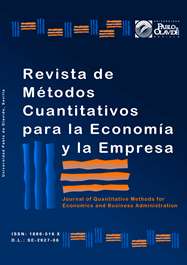Caracterización de la financiación para desarrollo en Colombia (2010-2018): caso empresa ACME SA
DOI:
https://doi.org/10.46661/revmetodoscuanteconempresa.5266Palabras clave:
caracterización, financiación, desarrollo, toma de decisiones, priorizaciónResumen
La investigación se centró en una problemática de financiación, a través del análisis de los datos históricos, en un periodo de 8 años, dada la factibilidad de contar con datos comparables, de la empresa ACME SA. El objetivo principal de este estudio fue proporcionar una caracterización actualizada de las inversiones de la firma ACME SA, en función de los departamentos y regiones del país, teniendo en cuenta: (i) cada departamento de Colombia; (ii) cada región del país (Amazónica, Andina, Caribe, Orinoquía y Pacífica); (iii) departamentos conforme a cuartiles de competitividad; (iv) departamentos conforme a los cuartiles de la contribución al producto interno bruto (PIB); y, finalmente, (v) departamentos conforme a cuartiles de población. Como metodología se utilizó principalmente la técnica de regresión lineal. Con base en ello los datos fueron agrupados por sector económico y departamental para analizar la cobertura. Por lo tanto, el resultado del estudio brinda una herramienta altamente fundamentada para la toma decisiones, como lo son el direccionamiento de la estrategia para la priorización del desarrollo a través de indicadores de gran relevancia como lo son el PIB, la población y la competitividad.
Descargas
Citas
Albarracín, A. (2019). Análisis e interpretación de las medidas descriptivas con estudiantes de ciclo V mediante el trabajo por proyectos. Bogotá: Universidad Nacional de Colombia. https://repositorio.unal.edu.co/bitstream/handle/unal/77997/TESIS%20VF_F.pdf
Banco de la República (julio-diciembre de 2018). Reporte de Estabilidad Financiera. https://repositorio.banrep.gov.co/bitstream/handle/20.500.12134/9536/reporte-estabilidad-financiera-segundo-semestre-2018.pdf?sequence=1&isAllowed=y
Calderón, R. (2005). La Banca de Desarrollo en América Latina. Financiamiento para el desarrollo. Serie 157, 1-44. http://hdl.handle.net/11362/5138
COLPROCE (14 de agosto de 2012). La banca de desarrollo: perspectiva para el crecimiento del agro. https://www.bcr.gob.sv/bcrsite/uploaded/content/category/1304062868.pdf
Consejo Privado de Competitividad & Universidad del Rosario (2018). Índice Departamental de Competitividad 2018. Bogotá: CPC.
DANE (2012). Clasificación industrial internacional uniforme de todas las actividades económicas. https://www.dane.gov.co/files/nomenclaturas/CIIU_Rev4ac.pdf
DANE (2020a). Censo Nacional. https://www.dane.gov.co/index.php/estadisticas-por-tema/demografia-y-poblacion/censo-nacional-de-poblacion-y-vivenda-2018
DANE (2020b). PIB por departamento. https://www.dane.gov.co/index.php/estadisticas-por-tema/cuentas-nacionales/cuentas-nacionales-departamentales
Gallardo (s.f.). Introducción al análisis clúster. Consideraciones generales. https://www.ugr.es/~gallardo/pdf/cluster-g.pdf
Gómez, M. (2002). El análisis clúster en investigación de marketing: Metodología y Crítica. Universidad Autónoma de Madrid, 1-21. https://www.researchgate.net/publication/283070714_EL_ANALISIS_CLUSTER_EN_INVESTIGACION_DE_MARKETING_METODOLOGIA_Y_CRITICA
Kulfas, M. (2018). Banca de desarrollo e inclusión financiera de las pequeñas y medianas empresas, Financiamiento para el desarrollo. Serie 269. Santiago de Chile: Comisión Económica para América Latina y el Caribe.
Matíz, F.J., & Fracica, G. (2011). La financiación de nuevas empresas en Colombia, una mirada desde la demanda. Revista Escuela de Administración de Negocios, 70, 118-130. https://doi.org/10.21158/01208160.n70.2011.538
Montero, R. (2016). Modelos de regresión lineal múltiple. Universidad de Granada. España: Documentos de Trabajo en Economía Aplicada.
Ocampo, J.A., Arias, P., & Torres, J.D. (2018). La banca nacional de desarrollo en Colombia. Ensayos sobre Política Económica (ESPE). https://doi.org/10.32468/espe.88
Pérez, L.R. (2015). Caracterización de las fuentes de financiación para el sector turismo en Santander (Colombia). Turismo y Sociedad, XVII, 103-126. https://revistas.uexternado.edu.co/index.php/tursoc/article/view/4446/5051
Rojo, J.M. (2007). Regresión Lineal Múltiple. Laboratorio de Estadística, 1-31. http://humanidades.cchs.csic.es/cchs/web_UAE/tutoriales/PDF/Regresion_lineal_multiple_3.pdf
Superintendencia Financiera de Colombia (2019). Actualidad del Sistema Financiero Colombiano. https://www.superfinanciera.gov.co/publicacion/10102799
Universidad de Santiago de Compostela (USC) (2012). Regresión Lineal Simple. http://eio.usc.es/eipc1/BASE/BASEMASTER/FORMULARIOS-PHP-DPTO/MATERIALES/Mat_50140116_Regr_%20simple_2011_12.pdf
Publicado
Cómo citar
Número
Sección
Licencia

Esta obra está bajo una licencia internacional Creative Commons Atribución-CompartirIgual 4.0.
El envío de un manuscrito a la Revista supone que el trabajo no ha sido publicado anteriormente (excepto en la forma de un abstract o como parte de una tesis), que no está bajo consideración para su publicación en ninguna otra revista o editorial y que, en caso de aceptación, los autores están conforme con la transferencia automática del copyright a la Revista para su publicación y difusión. Los autores retendrán los derechos de autor para usar y compartir su artículo con un uso personal, institucional o con fines docentes; igualmente retiene los derechos de patente, de marca registrada (en caso de que sean aplicables) o derechos morales de autor (incluyendo los datos de investigación).
Los artículos publicados en la Revista están sujetos a la licencia Creative Commons CC-BY-SA de tipo Reconocimiento-CompartirIgual. Se permite el uso comercial de la obra, reconociendo su autoría, y de las posibles obras derivadas, la distribución de las cuales se debe hacer con una licencia igual a la que regula la obra original.
Hasta el volumen 21 se ha estado empleando la versión de licencia CC-BY-SA 3.0 ES y se ha comenzado a usar la versión CC-BY-SA 4.0 desde el volumen 22.










